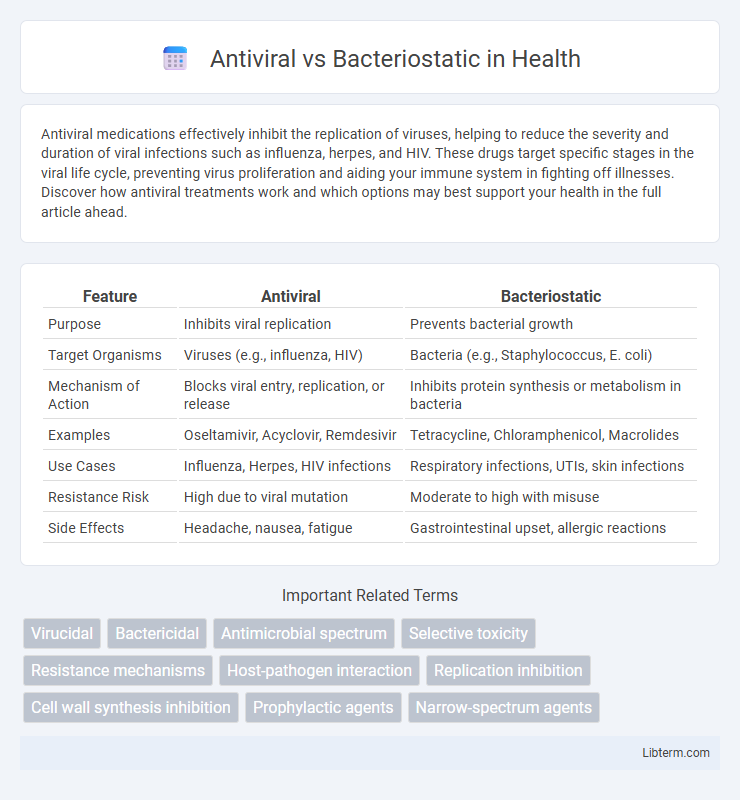Antiviral medications effectively inhibit the replication of viruses, helping to reduce the severity and duration of viral infections such as influenza, herpes, and HIV. These drugs target specific stages in the viral life cycle, preventing virus proliferation and aiding your immune system in fighting off illnesses. Discover how antiviral treatments work and which options may best support your health in the full article ahead.
Table of Comparison
| Feature | Antiviral | Bacteriostatic |
|---|---|---|
| Purpose | Inhibits viral replication | Prevents bacterial growth |
| Target Organisms | Viruses (e.g., influenza, HIV) | Bacteria (e.g., Staphylococcus, E. coli) |
| Mechanism of Action | Blocks viral entry, replication, or release | Inhibits protein synthesis or metabolism in bacteria |
| Examples | Oseltamivir, Acyclovir, Remdesivir | Tetracycline, Chloramphenicol, Macrolides |
| Use Cases | Influenza, Herpes, HIV infections | Respiratory infections, UTIs, skin infections |
| Resistance Risk | High due to viral mutation | Moderate to high with misuse |
| Side Effects | Headache, nausea, fatigue | Gastrointestinal upset, allergic reactions |
Understanding Antivirals and Bacteriostatics
Antivirals are specialized medications designed to target and inhibit the replication of viruses, effectively controlling viral infections such as influenza, HIV, and herpes. Bacteriostatics, on the other hand, work by inhibiting the growth and reproduction of bacteria without killing them outright, allowing the immune system to eliminate the pathogens. Understanding the mechanisms of antivirals and bacteriostatics is crucial for selecting appropriate treatments and preventing drug resistance in infectious diseases.
Key Differences in Mechanism of Action
Antiviral agents target viruses by inhibiting specific stages of viral replication, such as entry into host cells, nucleic acid synthesis, or viral protein assembly. Bacteriostatic agents inhibit bacterial growth and reproduction by interfering with essential bacterial processes like protein synthesis or metabolic pathways, without directly killing the bacteria. The key difference lies in antivirals targeting viral-specific mechanisms, while bacteriostatics primarily affect bacterial cellular functions to halt proliferation.
Target Pathogens: Viruses vs Bacteria
Antiviral agents specifically target viruses by interfering with viral replication processes, such as inhibiting viral enzymes or preventing viral entry into host cells. Bacteriostatic agents inhibit bacterial growth and reproduction by disrupting protein synthesis or metabolic pathways without killing the bacteria outright. The fundamental difference lies in their target pathogens: antivirals act against viruses, which are obligate intracellular parasites, while bacteriostatic drugs act against bacteria, which are living prokaryotic organisms.
Common Types of Antiviral Drugs
Common types of antiviral drugs include nucleoside analogs like acyclovir, which inhibit viral DNA replication, and protease inhibitors such as ritonavir that block viral enzyme activity essential for virus maturation. Other notable antivirals are neuraminidase inhibitors like oseltamivir, effective against influenza viruses, and entry inhibitors that prevent viruses from entering host cells. These drugs target specific stages of the viral life cycle, contrasting bacteriostatic agents that inhibit bacterial growth without directly killing bacteria.
Popular Bacteriostatic Agents
Popular bacteriostatic agents, such as tetracyclines, sulfonamides, and macrolides, inhibit the growth and reproduction of bacteria without directly killing them. These agents are crucial in managing bacterial infections by halting bacterial proliferation, allowing the immune system to eliminate the pathogens. Unlike antivirals that target viral replication mechanisms, bacteriostatics specifically disrupt bacterial protein synthesis or metabolic pathways to control infections.
Clinical Applications and Indications
Antiviral agents specifically target viral infections such as influenza, HIV, and herpes by inhibiting viral replication or entry, making them essential in clinical settings for managing viral diseases and preventing outbreaks. Bacteriostatic drugs inhibit bacterial growth and replication, effectively controlling infections like urinary tract infections, respiratory tract infections, and skin infections without directly killing the bacteria, which allows the immune system to clear the pathogens. Clinical applications of antivirals include treatment of chronic viral infections and post-exposure prophylaxis, while bacteriostatics are primarily indicated for bacterial infections where immune function can limit bacterial proliferation.
Side Effects and Safety Profiles
Antiviral medications primarily target viral replication with side effects including nausea, headaches, and potential liver toxicity, generally maintaining a favorable safety profile when used appropriately. Bacteriostatic agents inhibit bacterial growth and can cause side effects such as gastrointestinal disturbances, allergic reactions, and microbial resistance, requiring careful patient monitoring. Both classes of drugs necessitate adherence to prescribed dosages to minimize adverse effects and ensure optimal therapeutic outcomes.
Resistance Development in Pathogens
Antiviral agents target viruses by inhibiting their replication mechanisms, but resistance can develop through viral mutations altering target proteins or drug entry pathways. Bacteriostatic antibiotics inhibit bacterial growth without killing cells, promoting selective pressure that may lead to resistance via genetic mutations or horizontal gene transfer among bacteria. Monitoring resistance patterns in both viruses and bacteria is critical for guiding effective treatment strategies and minimizing the emergence of drug-resistant pathogens.
Choosing the Right Treatment Strategy
Choosing the right treatment strategy depends on accurately identifying whether the infection is viral or bacterial, as antiviral drugs specifically target viral replication mechanisms while bacteriostatic agents inhibit bacterial growth. Antiviral treatments, such as acyclovir or oseltamivir, are essential for managing infections caused by viruses like herpes simplex or influenza, whereas bacteriostatic antibiotics like tetracycline work by preventing bacterial protein synthesis to control infections. Effective diagnosis, including laboratory testing and symptom assessment, ensures the selection of the appropriate agent, reducing the risk of resistance development and improving patient outcomes.
Future Trends in Antimicrobial Therapies
Innovations in antimicrobial therapies increasingly emphasize antiviral agents targeting viral replication mechanisms, contrasting with bacteriostatic drugs that inhibit bacterial growth. Future trends include the development of broad-spectrum antivirals using RNA interference and CRISPR-based technologies, promising precise targeting with reduced resistance. Advances in nanotechnology and personalized medicine will enhance the efficacy and specificity of both antiviral and bacteriostatic treatments, revolutionizing infection management.
Antiviral Infographic

 libterm.com
libterm.com